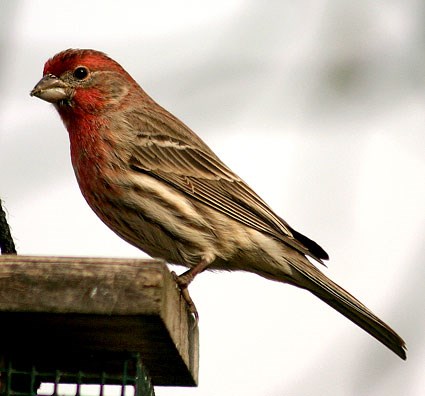We love watching birds and now that we are getting our own home, we will be doing whatever we can to attract birds to our home. Here are some resources toward that end.
Build Nest Boxes for Wild Birds
 The Oregon State Extension Service published a paper on building nesting boxes for wild birds.
The Oregon State Extension Service published a paper on building nesting boxes for wild birds.
Water Source
Provide a water source near protective shrubs during the summer months. On hot days, birds are especially eager to bathe and drink. Bird baths should be only an inch or two deep with a shallow slope; a dripping effect will lure more birds. Mount the bath on a pedestal if cats prowl your neighborhood. Clean it once a week with a stiff brush.
Bird Border
Create a bird border along your property edge by planting trees and shrubs that meet the needs of birds throughout the year. Select native plants adapted to the weather extremes of your local climate. The border can take the form of a hedge or windbreak, depending on your property size. Plant several of each species adjacent to each other, selecting a mix of plants, with the tallest planted at the edges of the property, and shorter species tiered toward your home. Include at least one species of thorny tree, such as hawthorn or raspberry, for nesting. Also include evergreens, such as spruce, holly, or juniper, for cover. Plant berry-producing shrubs such as dogwood, serviceberry, and viburnum that will provide fruit throughout the seasons. 
Spring Cleaning

Evening Grosbeak
Clean out old bird and mouse nests from nest boxes in early spring. When setting out new nest boxes, consider the preferred habitat for different species, as well as the size of the entrance hole, and its distance above the ground. Face boxes to the east in northern latitudes to provide extra warmth. In forests, play “woodpecker” by using a power drill to create 1 1⁄4-inch holes into dead snags 4 to 5 feet off the ground. These holes will serve as nest cavity starts for chickadees and titmice.
Leaf Piles Attract Birds!
Pile your leaves under shrubs to create mulch and natural feeding areas for ground-feeding birds such as sparrows, towhees, and thrashers. Earthworms, pill bugs, insects, and spiders will thrive in the decomposing leaf mulch, and will in turn be readily eaten by many songbirds. In general, overly tidy gardeners are poor bird gardeners!
Build a Meadow!

House Finch which is actually a wild bird found in our area
Favor meadow plants and taller grasses. Tall grasses provide seeds and nesting places for birds. Cut this meadow just once each year. Different species of birds have their favorite shrubs and bushes. Here are a few examples:
- Snowberry: grosbeaks, waxwings, robins, thrushes, towhees, and hummingbirds
- Western columbine: sparrows, juncos, finches, hummingbirds
- Lupine: songbirds and hummingbirds
- Coneflower: finches
Do not deadhead flower blossoms in the late summer and fall; wait until the end of winter. Allowing them to go to seed will provide the birds with high-energy food for the shortened and cooler days. Let parsley, broccoli and greens go to seed to attract goldfinches, chickadees, junco, sparrows and house finches. Planting sunflowers or millet and letting the heads go to seed will attract a multitude of birds.
And to bring the butterflies in, plant some of the following:

Washington State’s endangered
Taylor’s Checkerspot
- Lavender: Attracts bumblebees, carpenter bees, digger bees and large and small leafcutting bees.
- Pacific or coast rhododendron (Rhododendron macrophyllum): Larval host for brown elfin and gray hairstreak butterflies. Attracts hummingbirds, bees and Western tiger swallowtails.
- Blueblossom (Ceanothus thyrsiflorus): Larval host for pale swallowtail, California tortoiseshell and echo blue butterflies. Attracts bumblebees, carpenter bees, honeybees, digger bees and a variety of small native bees.
- Ocean spray (Holodiscus discolor): Larval host for spring azure, brown elfin and Lorquin’s admiral butterflies. Bumblebees and a variety of small native bees are attracted to ocean spray.
- Serviceberry (Amelanchier alnifolia): Larval host for Weiddemeyer’s admiral butterflies. Draws hummingbirds, bees and butterflies.
- Russian sage (Perovskia atriplicifolia): Entices honeybees, small carpenter bees leafcutting bees, and hummingbirds.
- Red-flowering currant (Ribes sanguineum): Draws early-season butterflies and hummingbirds.
- Zinnias: Attract many different types of hummingbirds, butterflies and bees.
- Sunflower: Entices Longhorn bees, sweat bees, leafcutting bees and bumblebees.
- Salal (Gaultheria shallon): Larval host for spring azure butterflies. Attracts various types of bees.
- Catmint (Nepeta): Draws honeybees, bumblebees, carder bees and mason bees.
- Showy milkweed (Asclepias speciosa): Attracts monarch butterflies because they lay their eggs on showy milkweed and collect nectar and pollen from it. Hummingbirds are also drawn this plant.
More information is available at Portland Nursery.
 The Columbia Land Trust and the Audobon Society of Portland provide a program to certify backyard habitats which involves removing invasive species, naturescaping with native plant species and providing habitats for wildlife. Unfortunately, the program has not been extended to Vancouver yet, but it hopefully will be soon. View the brochure by clicking on the image (right).
The Columbia Land Trust and the Audobon Society of Portland provide a program to certify backyard habitats which involves removing invasive species, naturescaping with native plant species and providing habitats for wildlife. Unfortunately, the program has not been extended to Vancouver yet, but it hopefully will be soon. View the brochure by clicking on the image (right).